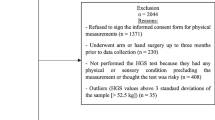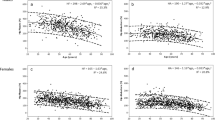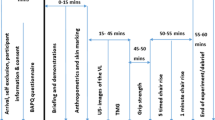Abstract
Age-related changes in muscle quality and muscle mass in the forearm, which relate to decline in handgrip strength (HGS), have not been reported. The purpose of this study was to investigate the relationships between age-related declines in HGS and loss of muscle thickness and/or muscle quality in the forearm of 613 adults (306 men and 307 women) aged 20–89. Anterior forearm muscle thickness (MT-ulna) and HGS were measured using an ultrasound and a hand dynamometer, respectively, in the dominant hand. Muscle quality (fMQ) was defined as a ratio of HGS to MT-ulna. HGS was similar among younger (ages 20–29, 30–39, and 40–49) groups and was progressively lower with increasing age in both sexes. MT-ulna was similar between ages 20–29 and 60–69 in men and between ages 20–29 and 70–79 in women. In men, MT-ulna was lower in ages 70–79 and 80–89 compared with other age groups. In women, MT-ulna was lower in ages 80–89 compared with ages 20–29 and 40–49. In both men and women, fMQ was identical among younger (ages 20–29, 30–39, and 40–49) groups. After that fMQ was progressively lower with age in both men and women. The results indicated that age-related decline in HGS is associated with fMQ, but it appears to be accelerated after the seventh decade due to muscle loss.
Similar content being viewed by others
References
Abe T, Loenneke JP, Thiebaud RS, Loftin M (2014a) Morphological and functional relationships with ultrasound measured muscle thickenss of the upper extremity and trunk. Ultrasound 22:229–235
Abe T, Thiebaud RS, Loenneke JP, Ogawa M, Mitsukawa N (2014b) Association between forearm muscle thickness and age-related loss of skeletal muscle mass, handgrip and knee extension strength and walking performance in old men and women: a pilot study. Ultrasound Med Biol 40:2069–2075
Abe T, Counts BR, Barnett BE, Dankel SJ, Lee K, Loenneke JP (2015a) Associations between handgrip strength and ultrasound-measured muscle thickness of the hand and forearm in young men and women. Ultrasound Med Biol 41:2125–2130
Abe T, Thiebaud RS, Loenneke JP, Young KC (2015b) Prediction and validation of DXA-derived appendicular lean soft tissue mass by ultrasound in older adults. Age (Durdr) 37:114
Al Snib S, Markides KS, Ray L, Ostir GV, Goodwin JS (2002) Handgrip strength and mortality in older Mexican Americans. J Am Geriatr Soc 50:1250–1256
Cawthon PM, Fox KM, Gandra SR, Delmonica MJ, Chiou CF, Anthony MS, Sewall A, Goodpaster B, Satterfield S, Cummings SR, Harris TB (2009) Do muscle mass, muscle density, strength, and physical function similar influence risk of hospitalization in older adults? J Am Geriatr Soc 57:1411–1419
Cruz-Jentoft AJ, Baeyens JP, Bauer JM, Boirie Y, Cederholm T, Landi F, Martin FC, Michel JP, Rolland Y, Schneider SM, Topinkova E, Vandewoude M, Zamboni M, European Working Group on Sarcopenia in Older People (2010) Sarcopenia: European consensus on definition and diagnosis: Report of the European Working Group on Sarcopenia in Older People. Age Ageing 39:412–423
Doherty TJ (2003) Invited review: aging and sarcopenia. J Appl Physiol 95:1717–1727
Leong DP, Teo KK, Rangarajan S, Lopez-Jaramillo P, Avezumi Jr A, Orlandini A, Seron P, Ahmed SH, Rosengren A, Kelishadi R, Rahman O, Swaninathan S, Iqbal R, Gupta R, SA L, Oguz A, Yusoff K, Zatonska K, Chifamba J, Igumbor E, Mohan V, Anjana RM, Gu H, Li W, Yusuf S, Prospective Urban Rural Epidemiology (PURE) Study Investigators (2015) Prognostic value of grip strength: findings from the prospective urban rural epidemiology (PURE) study. Lancet 386:266–273
Giampaoli S, Ferrucci L, Cecchi F, Lo Noce C, Poce A, Dima F, Santaquilani A, Vescio MF, Menotti A (1999) Hand-grip strength predicts incident disability in non-disabled older men. Age Ageing 28:283–288
Hairi NN, Cumming RG, Naganathan V, Handelsman DJ, Le Couteur DG, Creasey H, Waite LM, Seibel MJ, Sambrook PN (2010) Loss of muscle strength, mass (sarcopenia) and quality (specific force) and its relationship with functional limitation and physical disability: the Concord health and ageing in Men Project. J Am Geriatr Soc 58:2055–2062
Kallman DA, Plato CC, Tobin JD (1990) The role of muscle loss in the age-related decline of grip strength: cross-sectional and longitude perspectives. J Gerontol 45:M82–M88
Koopman JJ, van Bodegom D, van Heemst D, Westendorp RG (2015) Handgrip strength, ageing and mortality in rural Africa. Age Ageing 44:465–470
Lauretani F, Russo CR, Bandinelli S, Bartali B, Cavazzini C, Di Iorio A, Corsi AM, Rantanen T, Guralnik JM, Ferrucci L (2003) Age-associated changes in skeletall muscle and their effect on mobility: an operational diagnosis of sarcopenia. J Appl Physiol 95:1851–1860
Leong DP, Teo KK (2015) Predicting cardiovascular disease from handgrip strength: the potential clinical implications. Expert Rev Cardiovasc Ther 13:1277–1279
Luna-Heredia E, Martin-Pena G, Ruiz-Galiana J (2005) Handgrip dynamometry in healthy adults. Clin Nutr 24:250–258
Manini TM, Clark BC (2012) Dynapenia and aging: an update. J Gerontol A Biol Sci Med Sci 67:28–40
Metter EJ, Talbot LA, Schrager M, Conwit R (2002) Skeletal muscle strength as a predictor of all-cause mortality in healthy men. J Gerontol A Biol Sci Med Sci 57:B359–B365
Newman AB, Haggerty CL, Goodpaster B, Harris T, Kritchevsky S, Nevitt M, Miles TP, Visser M (2003) Strength and muscle quality in well-functioning cohort of older adults: the health, aging and body composition study. J Am Geriatr Soc 51:323–330
Newman AB, Kupelian V, Visser M, Simonsick EM, Goodpaster BH, Kritchevsky SB, Tylavsky FA, Rubin SM, Harris TB (2006) Strength, but not muscle mass, is associated with mortality in health, aging and body composition study cohort. J Gerontol A Biol Sci Med Sci 61:72–77
Rantanen T, Masaki K, Foley D, Izmirlian G, White L, Guralnik JM (1998) Grip strength changes over 27 yr in Japanese-American men. J Appl Physiol 85:2047–2053
Rantanen T, Guralnik JM, Foley D, Masaki K, Leveille S, Gurb JD, White L (1999) Midlife hand grip strength as a predictor of old age disability. JAMA 281:558–560
Rantanen T, Harris T, Leveille SG, Visser M, Foley D, Masaki K, Guralnik JM (2000) Muscle strength and body mass index as long-term predictors of mortality in initially healthy men. J Gerontol A Biol Sci Med Sci 55:M168–M173
Ruiz JR, Sui X, Lobelo F, Morrow JR Jr, Jackson AW, Sjostrom M, Blair SN (2008) Association between muscular strength and mortality in men: prospective cohort study. BMJ 337:a439
Sasaki H, Kasagi F, Yamada M, Fujita S (2007) Grip strength predicts cause-specific mortality in middle-aged and elderly persons. Am J Med 120:337–342
Vianna LC, Oliveira RB, Araujo CG (2007) Age-related decline in handgrip strength differs according to gender. J Strength Cond Res 21:1310–1314
Weir JP (2005) Quantifying test-retest reliability using the intraclass correlation coefficient and SEM. J Strength Cond Res 19:231–240
Acknowledgments
Our appreciation is extended to the men and women who participated in this study. We also thank Akemi Abe for her assistance in the testing of this study.
Author information
Authors and Affiliations
Corresponding author
Ethics declarations
This study was partly supported by the Japanese Society of Wellness & Preventive Medicine funded research (TA). Takashi Abe, Robert Thiebaud and Jeremy Loenneke declare that they have no conflicts of interest relevant to the content of this manuscript.
About this article
Cite this article
Abe, T., Thiebaud, R.S. & Loenneke, J.P. Age-related change in handgrip strength in men and women: is muscle quality a contributing factor?. AGE 38, 28 (2016). https://doi.org/10.1007/s11357-016-9891-4
Received:
Accepted:
Published:
DOI: https://doi.org/10.1007/s11357-016-9891-4




